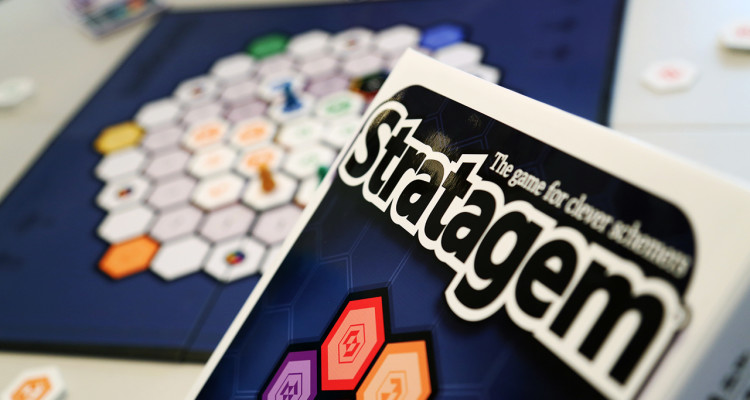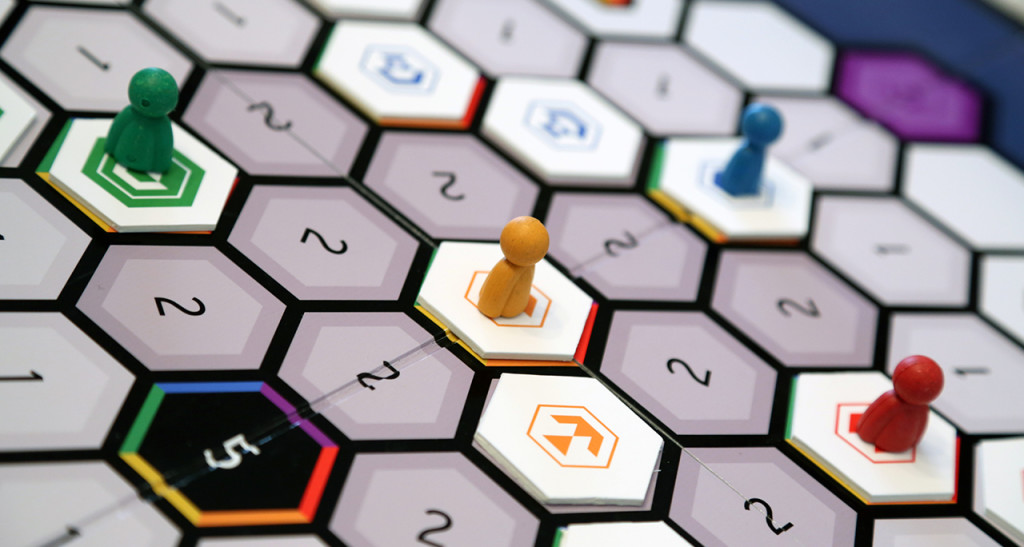While many games look to a topic, concept, or moment in time as inspiration for design, there are others that seek to strip away the excess in favor of simplicity. It is the latter type that stand solely on the merit of their mechanics and the ability to support raw tactical decision-making. In Stratagem, players will experience just that, as they engage in a battle for control of the board, not for the honor of their King or in the pursuit of great riches – but simply because the rules say so.
Design
Stratagem is a light, abstract game for 2-6 players from James O’Reilly and 6th Gear Games. Simply put, Stratagem is a game in which players are vying for control of board hexes in order to score points and reach the winning score total. In order to control a space though, a player must first claim and control it via movement or combat. As it moves, your pawn will leave a wake of claims that, if uncontested over a full turn, will come under your control. It’s with these controlled spaces that you will score points based on the hex’s value.
The design of Stratagem is aesthetically simple, yet pleasing. It is clear from the Kickstarter campaign page and the game’s design that James O’Reily wanted a game that felt vibrant, clean and modern. The tiles in this version of the prototype are made of a light foam board and the game board is a sturdy, quality construction. The graphic design and components are also very clear, concise and friendly to those who may have issues with color blindness. One thing I’d like to see (and may still happen) is a more obvious contrast between the claimed and controlled sides of the hex tiles. A full-color controlled side would make the “barrier” that is created by a player’s controlled tiles easier to see. There are differing designs on either side, but this suggestion is merely to enhance the contrast.
Gameplay
Setup for Stratagem is extremely quick. Players select a color from the 6 options available and receive a matching colored pawn and set of hexagon tiles. Starting position on the board is dictated by the number of players in the game. The deck of Action Cards is shuffled and 3 cards are dealt to each player face down; the remaining cards create a draw deck on the side of the gameboard. Starting player is selected by rolling the 6-colored battle die. The player whose color is rolled goes first (next clockwise person if no one is playing that color). The last thing to do is decide on a target score for the win condition. There are a number of recommended scoring totals for various player sizes but its ultimately up to you to decide on this.
You are now ready to play Stratagem!
PLAYER’S TURN
A player’s turn will consist of the following 3 phases—all conveniently starting with the letter “C”—in the order listed, when applicable:
 Clear all of the active player’s hexes currently on the board in the control position (darker side up);
Clear all of the active player’s hexes currently on the board in the control position (darker side up);- Control spaces which have been claimed on the prior turn by flipping your hex tile to the control position. Players will score points based on value of the newly-controlled spaces. It’s also worth noting that players may not enter a controlled space, which creates a barrier that forces opponents to navigate around. However, the controlling player may move freely through their own controlled spaces; and
- Claim any new spaces by rolling the movement die and placing a new hex (light side up) on any unoccupied or opponent-claimed space your pawn crosses.
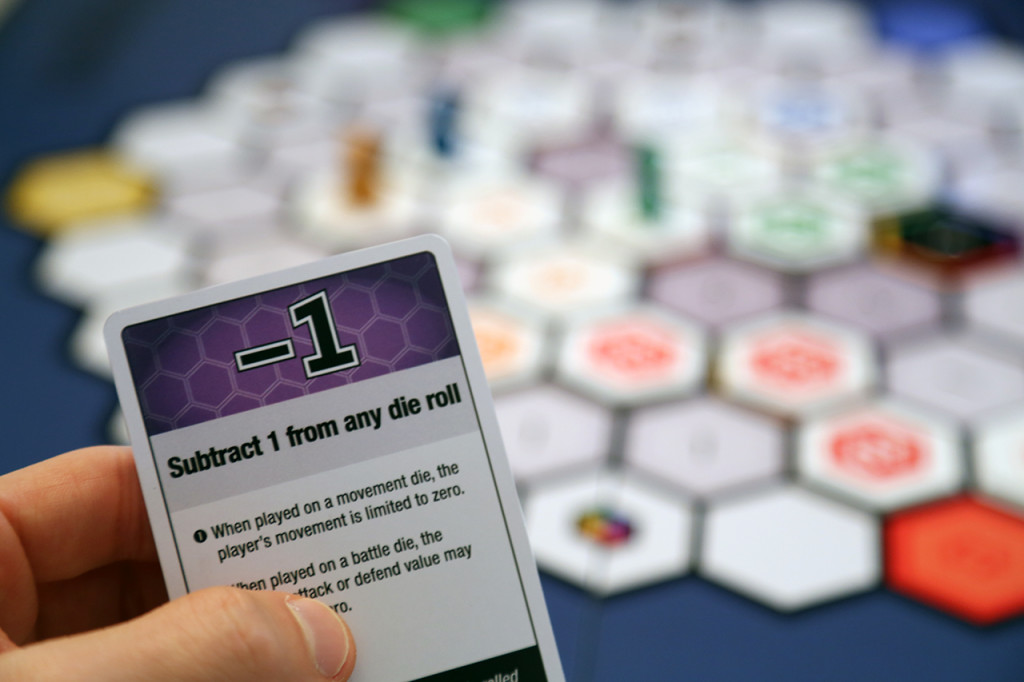 If at any point your pawn enters the same hex as an opposing player’s pawn, you must stop your movement and prepare for battle. Players will each roll one of the battle dice and compare numbers–highest roll wins (ties to the defender) and the loser must retreat to their home space with a frown.
If at any point your pawn enters the same hex as an opposing player’s pawn, you must stop your movement and prepare for battle. Players will each roll one of the battle dice and compare numbers–highest roll wins (ties to the defender) and the loser must retreat to their home space with a frown.
To aid in reducing the randomness of the movement and battle mechanics, Action Cards can grant players with bonus effects to their die roll, among other abilities (e.g. Rematch, Mulligan, Teleport, etc.). Players may play one action card per turn. The cards specify during which phase of the turn the card can be played.
The first player to reach the designed score is the winner!
Overall Experience
Stratagem is a light, streamlined, hybrid abstract game approachable by players of all skill sets and ages. The basic rules are simple and easily taught in 5 minutes, while some of the action cards may require reference to the player guide. The base Stratagem game has players rolling a die for movement as well as simple combat. I will be the first to say that, while I dislike roll and move games, the layout of both the movement die and the game board in Stratagem guarantees that players will have enough options to make their turn worthwhile. There are no wasted turns. The movement die allows players to move their pawn either 2, 3, or 4 spaces. Yes, rolling a 4 is still better than rolling a 2, but it’s not completely detrimental to your plan and can potentially be mitigated with Action Cards in hand. It is up to the players to use their movement roll to optimize their path along the board.
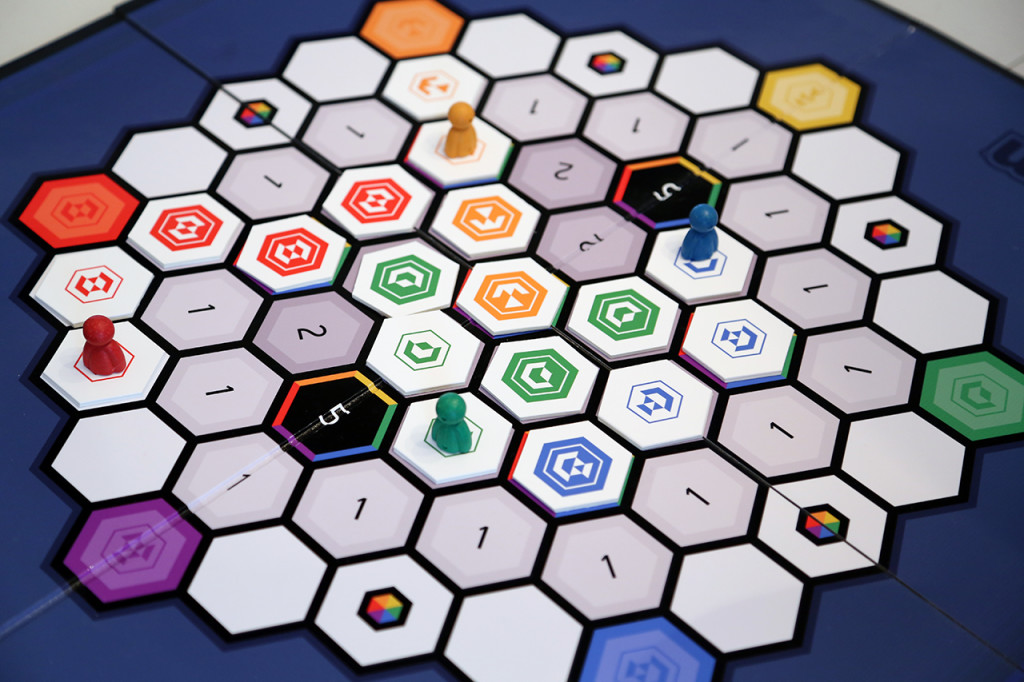
The board is laid out in a way that naturally creates tension amongst the players. The 10 point spot is smack-dab in the middle of the board surrounded by a variety of 5, 2, and 1-point spaces. Often times your first inclination is to go directly to the center of the board, but do you want to risk having a target on your head going for the 10 point spot in the center, or would you rather live on the edges collecting 2 and 5-point spaces? An even better choice might be stealing them from your opponents!
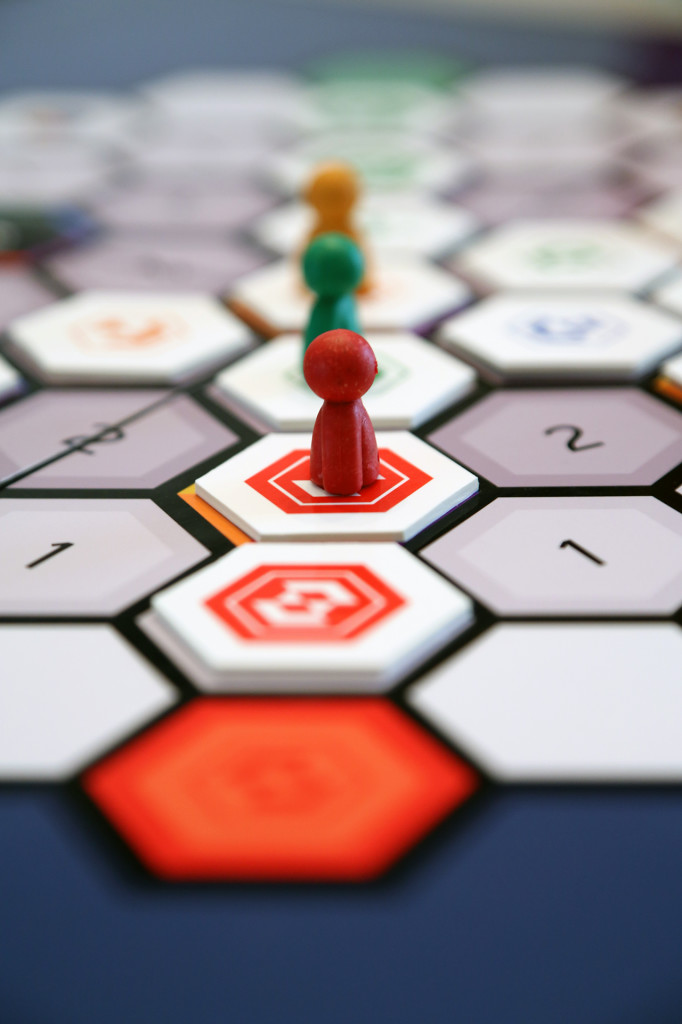 The Action Cards add another level of strategy by allowing you to mitigate some of the random die rolls and provide additional “take that” options. You start the game with 3, but once your hand runs out it can be difficult to replenish due to the location of the Action Card hexes. The decision has to be made whether or not having the extra Action Card is worth venturing to the outer edge of the game board, far away from the point-hexes. In our experience, we found that players would essentially “lose” a turn in order to get a new Action Card and, in a game where points each turn are crucial, it didn’t feel like the optimal strategy in most cases.
The Action Cards add another level of strategy by allowing you to mitigate some of the random die rolls and provide additional “take that” options. You start the game with 3, but once your hand runs out it can be difficult to replenish due to the location of the Action Card hexes. The decision has to be made whether or not having the extra Action Card is worth venturing to the outer edge of the game board, far away from the point-hexes. In our experience, we found that players would essentially “lose” a turn in order to get a new Action Card and, in a game where points each turn are crucial, it didn’t feel like the optimal strategy in most cases.
While available for play with as little as 2 players, Stratagem shines with 4, 5 or 6 players. With a higher player count, the board congestion allows for more strategic movement decisions and really puts the “take that” aspect of the game in full swing. Games played with less than 4 are not as contentious and prove to be more an exercise in optimizing your movement on one side of the board. Player interaction is what this game is all about; highlighted by the 2-step claim/control mechanic. It is quite feasible that those spaces you just worked so hard to claim this turn may not be yours to control once your opponents have had their say!
Fans of light abstract games will do well to check out Stratagem. I don’t typically associate abstract strategy games with random die rolling movement and combat, but Stratagem walks a fine line in balancing enough strategy to keep players engaged and enough luck not to dissuade players from enjoying themselves. For players seeking a more pure abstract gaming experience, there are a number of variants available to tailor your game to be more strategic, with little to no luck involved, such as removing the battle and movement dice.
LEAGUE RULING
NaD
I find that my tastes lend themselves to more strategic games devoid of as much randomness as possible. So when I first read about Stratagem, an abstract strategy game with dice rolling movement and combat, I was hesitant yet intrigued. Stratagem is not your typical abstract game; and from what I found out, that is certainly not a negative!
The movement and combat mechanics are simple, maybe too simple, but they still provide a nice tension when journeying across the board and squaring off with your opponent to lay claim to the spaces once and for all (or at least until the next player tries to take it from you). And having to wait a full round to see if your claimed spaces hold up is always nerve-wracking.
The variant rules that can be mixed in allow you to tailor the game based on the preferences of those players at the table without hindering the core mechanics. If I’m playing with my regular group, luck and randomness are sometimes a hard sell whereas if I’m playing with my family, the crazier the better. Stratagem‘s versatility in this regard is very well-executed.
Everything from the mechanics to the graphic design and layout are smooth and streamlined. As stated above, I personally feel Stratagem needs at least 4 players to make it a worthwhile addition to game night. I want my games involving randomness to be as interactive as possible and with less than 4 players the game suffers, in my opinion. Overall, the easy to learn/teach rule-set and quick play time, make Stratagem a great option for a family game night or the casual lead-off hitter for your weekly gaming group.
Steebin
Stratagem is one of those games that has a great concept, but is very tricky to execute and keep everything well-balanced. I enjoyed capturing and securing points, as well as, trying to battle other players for the coveted 10-point spot smack-dab in the middle of the board. The game does offer many different variants to accommodate different play styles. I think I enjoyed the roll and move mechanic best with, at least, 4 players. On the first play through, the cards seemed to be scarce since no one was going for the card hexes on the board. After a rules revision it seemed like there were way too many cards in play. My final thought on this game is that the idea, execution and design is done very well, I just don’t know how long the game will hold interest after a few plays.
Buns
Stratagem is a well-crafted game featuring slick graphic design, a simple rule set and high production value, even in prototype form. There is a lot to enjoy about the look and feel of this game. However, in terms of gameplay, the attempt at combining abstract strategy with dice-based randomness has drawn a line in the sand, and whether this game hits home or not depends on where you’re standing.
I see Stratagem as best filling the gaps between more casual and mainstream games, such as checkers or Sorry, and “designer games.” This is because a game of Stratagem is very easy and approachable; it feels familiar, while still being something very different. A particular boon is that this game actually functions best with 4+ players. Not something typical for the hobby overall, let alone an abstract strategy game, this makes Stratagem a nice party game-ish option for a large group or the beginning of a game night.
On the flip side, it could be difficult to justify repeated plays of Stratagem to more entrenched or experienced gamers. While this game brings a lot to the table as a more casual/light game, the marrying of strategy elements and dice in this game may fall flat for some. Your more strategic friends may become frustrated when their carefully premeditated plan is foiled because they rolled a 2, or because someone had a card that sent them back to Home. This type of interaction happens in many games, but it is the pitch that Stratagem is an “abstract strategy game” that makes this problematic.
When it comes down to it, the choice must always be made based on your preferences and the style of your group. If you often host large groups or have a few gamer friends that love a “take that” approach to abstract games, you might want to head over to the Kickstarter page. Plus, did I mention it’s only a $28 commitment? How often does that happen in this hobby?
Smee’s Two Pence
Stratagem may be an abstract game, but the rules are simple and easy to teach. Suitable for family gaming nights or casual play, it tries to blend tactical gameplay and a healthy dose of luck with predictable results. As for the cards meant to mitigate that luck, well—a) Everybody else also has them, and b) Your limited hand runs out quickly, and the barren wasteland surrounding the card spaces make it exceptionally unappealing to try and fetch one. A variant adds a card draw to each of the multicolor spaces (5 and 10 points), which perhaps serves to overpower them in comparison. It’s a difficult balance to master, and Stratagem perhaps misses the mark in regards to the serious gamer. Given this, I’ll award one thumb up in the Casual Abstract category.
The League of Nonsensical Gamers would like to thank 6th Gear Games for kindly providing us with a prototype of Stratagem for this preview.
Stratagem is currently funding over on Kickstarter. If this game piques your interests, head on over to the campaign page by May 30, 2014 to claim and control your own copy. For $28, you receive a copy of the game along with all reached stretch goals.

